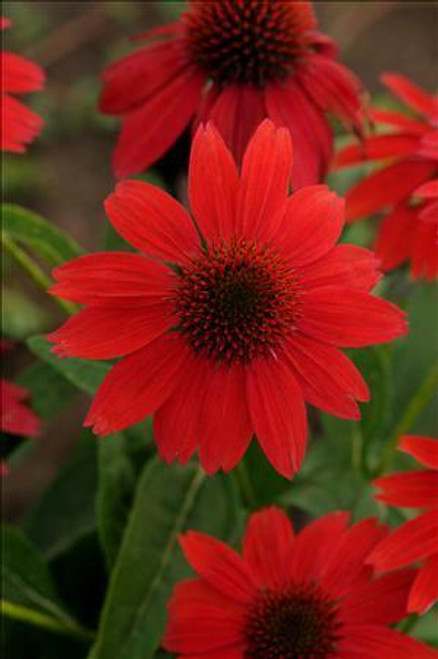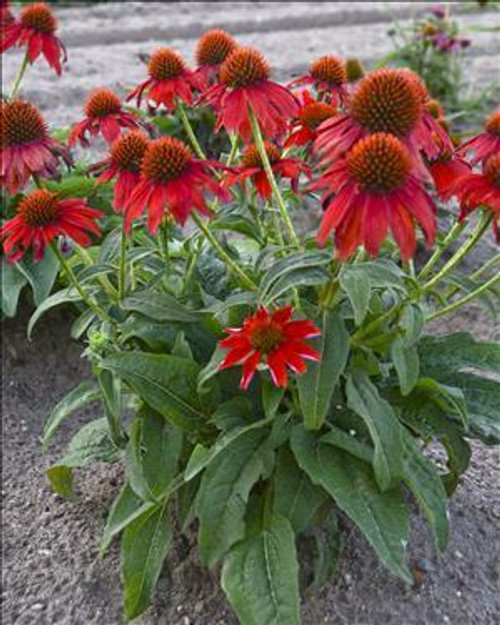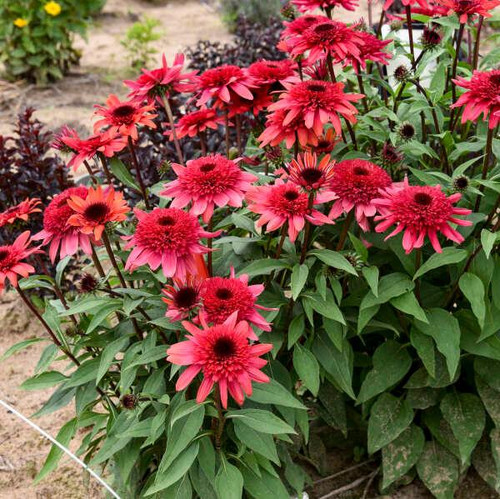Product Description
Echinacea 'Knock 'em Red' PPAF CPBRAF - Proven Winners® COLOR CODED® Collection (30)ct Flat
(COLOR CODED® Collection) (PPAF: Plant Patent Applied For - US; CPBRAF: Community Plant Breeders' Rights Applied For - EU)
Common Name: Coneflower 'Knock 'em Red'
Part of the COLOR CODED® Collection, 'Knock 'em Red' is a modern Coneflower cultivar bred for exceptional garden performance and striking, consistent color. Produced vegetatively to ensure every plant is identical in habit and flower, this variety stands out with large, 4-inch wide blossoms that undergo a dramatic color transformation. Flowers emerge a deep crimson red before maturing to a vibrant, eye-catching fluorescent red. True to the collection's standards, 'Knock 'em Red' boasts excellent basal branching for a full, sturdy plant and features petals held horizontally, offering a bold, non-drooping display. It's a magnet for pollinators during its mid-to-late summer bloom period and provides valuable food for birds with its seed heads in fall and winter.
'Knock 'em Red' offers vibrant color and reliable garden performance:
- Intense, Shifting Color: Large, 4-inch flowers open deep crimson and mature to a fluorescent red, creating a dynamic display.
- Horizontal Petals: Ray petals are held horizontally, maximizing the flower's visual impact compared to more traditional drooping forms.
- Excellent Branching: Selected for strong basal branching, resulting in a fuller, multi-stemmed plant with more flowers.
- Uniformity: Propagated from tissue culture, ensuring consistent growth habit and color expression across all plants.
- Long Bloom Season: Flowers reliably from midsummer through late summer, with potential for extended bloom if deadheaded.
- Pollinator Magnet: Highly attractive to bees and butterflies, supporting garden biodiversity.
- Wildlife Value: Seed heads provide food for goldfinches and other songbirds in fall and winter, adding ecological benefit and winter interest.
- Deer Resistant: Generally avoided by deer.
- Fragrance: May possess a light, sweet fragrance, typical of some coneflowers.
- Patent Protection: PPAF and CPBRAF status indicates propagation rights are protected for this new variety.
- Habit: Forms an upright, well-branched, clump-forming herbaceous perennial.
- Flowers: Large, 4-inch (10 cm) diameter composite flowers. Features prominent, sturdy ray petals (florets) surrounding a large, bristly central cone (disk florets) that is typically coppery-brown. Petals are held horizontally.
- Foliage: Leaves are typically medium to dark green with a somewhat coarse texture. Basal leaves are larger, often ovate to lance-shaped, while leaves further up the stems are smaller and narrower.
- Size: Reaches a mature height of 20 to 24 inches (51−61 cm) with a spread of 16 to 20 inches (41−51 cm).
- Height: 20 - 24 inches (51−61 cm)
- Spread: 16 - 20 inches (41−51 cm)
- Flower Size: 4 inches (10 cm)
- Flower Color: Deep Crimson maturing to Fluorescent Red
- Foliage Color: Green
- Bloom Time: Midsummer to Late Summer
- Hardiness Zones: USDA Zones 4 - 8
- Sun Exposure: Full Sun (6+ hours direct sun) is strongly recommended for best flowering and strongest stems. Tolerates light afternoon shade.
- Water Needs: Low to Average. Drought tolerant once established.
- Soil: Adaptable to poor, average, or fertile soil, BUT must be well-drained. Avoid consistently wet conditions, especially in winter.
- Soil pH: Adaptable (Acidic, Neutral, Alkaline); Prefers Neutral to slightly Alkaline.
- Growth Rate: Medium
- Origin: Cultivar derived from North American native Echinacea species.
- Status: PPAF (US), CPBRAF (EU)
- Features: Attracts Bees, Butterflies, Songbirds (seeds); Deer Resistant; Excellent Cut Flower; Good for Dried Arrangements; Drought Tolerant; Strong Branching; Horizontal Petals; Fragrant Flowers (potential).
Native Habitat
The genus Echinacea is native to the tallgrass prairies and open woodlands of eastern and central North America. These native coneflowers are known for their resilience and adaptability. 'Knock 'em Red' is a modern, complex hybrid developed through horticultural breeding programs, selecting parent plants from native species to achieve its unique combination of vibrant red color, large flower size, strong branching, and horizontal petals for enhanced garden performance.
Landscaping Design Tips
The intense color and sturdy habit of 'Knock 'em Red' make it a valuable addition to many garden settings:
- Perennial Borders: Perfect for adding bold, long-lasting color to the front or middle of sunny borders.
- Mass Planting: Planting in groups of three or more, or in large drifts, creates a stunning visual impact. Space plants approximately 18-20 inches apart. This approach maximizes the color show and support for pollinators.
- Prairie and Meadow Gardens: Fits perfectly into naturalistic planting schemes, combining well with ornamental grasses and other prairie natives.
- Cottage Gardens: Adds vibrant color and attracts wildlife, complementing traditional cottage garden styles.
- Containers: Suitable for larger patio containers (ensure excellent drainage) where its flowers can be enjoyed up close.
- Cutting Gardens: Provides long-lasting, vibrant blooms for fresh floral arrangements.
- Wildlife Gardens: Essential for attracting pollinators and providing winter food for birds – remember to leave the seed heads standing!
- Companion Planting: Pairs beautifully with ornamental grasses like Switchgrass (Panicum virgatum) or Little Bluestem (Schizachyrium scoparium), Black-Eyed Susans (Rudbeckia), Blazing Star (Liatris), Stonecrop (Sedum), Phlox, and Salvias.
Hardiness
Echinacea 'Knock 'em Red' is reliably hardy in USDA Zones 4 through 8. It is a herbaceous perennial, meaning its top growth dies back to the ground each winter, and new growth emerges from the crown in spring. While generally robust, ensuring excellent soil drainage is crucial for the long-term survival of modern Echinacea hybrids, especially through wet winters.
Planting and Cultivation
Follow these guidelines for success with 'Knock 'em Red':
- Timing: Plant in spring or early fall to allow roots to establish before extreme heat or cold. (Current date: May 2, 2025 - Spring planting is ideal now).
- Location: Full sun (minimum 6 hours direct sun daily) is essential for strong stems and abundant flowering. Plants may become leggy or flop in too much shade.
- Soil Preparation: Excellent drainage is critical. Amend heavy clay soils with compost and potentially horticultural grit or coarse sand to improve drainage. Echinacea dislikes "wet feet," especially during winter dormancy. While adaptable to various fertility levels, avoid overly rich soil.
- Planting: Dig a hole slightly wider than the pot. Gently remove the plant and place it in the hole so the crown (where the stem meets the roots) is level with or slightly above the surrounding soil surface. Backfill the hole, firm the soil gently, and water thoroughly.
- Spacing: Space plants 16 to 20 inches (41−51 cm) apart to allow for mature size and good air circulation.
- Watering: Water regularly during the first growing season. Once established, coneflowers are quite drought-tolerant. Water deeply but infrequently during prolonged dry spells, especially when flowering. Allow the soil to dry out somewhat between waterings.
- Fertilizing: Echinacea generally requires little to no supplemental fertilizer. A light application of compost around the base in spring is usually sufficient. Avoid high-nitrogen fertilizers.
- Maintenance:
- Deadheading: Removing spent flowers during the blooming season can encourage the plant to produce more blooms. Snip the stem back to just above a set of leaves or a lateral bud.
- Winter Interest/Bird Food: Stop deadheading in late summer or early fall to allow seed heads to form. Leave these standing through winter for visual interest and to provide food for birds.
- Spring Cleanup: Cut back the dead stems and foliage to the ground in late winter or early spring, just before new basal growth emerges.
- Pests and Diseases: Generally robust. Potential issues include leaf spot or powdery mildew (less likely with good air circulation in full sun), aster yellows (a disease spread by leafhoppers, causing distorted growth - remove infected plants), and root rot in poorly drained soils. Monitor for Japanese beetles which may feed on flowers. It is reliably deer resistant.
Thirty (30) plants per flat (or tray). Approximate Plug Measurements: 3 inches deep x 2 inches wide.
Other Details
The most important part of the plant is its root system. Healthy roots are the foundation of a healthy, vibrant plant. The type of plug container used is based on the specific needs of the plants. Perennials offered as bare root traditionally perform better when planted as bare root.Planted in a specialized mix, potted plants have well established root systems. Top growth stage will vary depending on the current life cycle and time of year when shipped. In Winter and early Spring dormant plants may be shipped. Dormant plants may be planted right away, even before the last frost date.
Most bare root varieties are field grown for at least one season, though Hemerocallis and Hosta are grown for two seasons. The bulk of the soil is removed during the harvesting process and the tops of most varieties are trimmed back to the crown. They are graded, packed in shredded aspen or sphagnum moss and stored in freezers until ready to be shipped.
See our Container Sizes and Bare Root Perennials pages for more information.
Plant information and care is provided in the Overview section, Plant Genus Page and general information is provided in the Planting Care & Guides. Additional questions can be asked on each Plant page.
Plant Spacing: Using the maximum mature spread or width of a plant to guide spacing, ensures space to grow to full size. To fill an area sooner, plant them closer together. Just remember, future thinning or transplanting may be needed.
Water: Keep a close eye on newly planted perennials, especially throughout the first growing year. Most early plant loss is due to too much or too little water!












